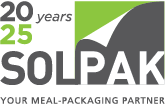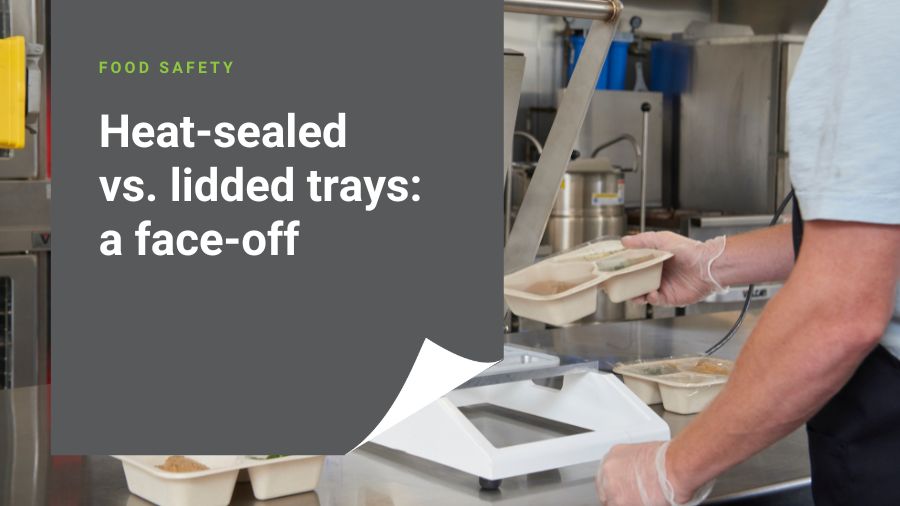Ensuring food safety and freshness is crucial in the food service industry. Heat-sealed trays stand out from traditional lidded trays by offering clear benefits for preserving ready-to-serve meals. Their advanced design effectively protects food from contaminants and maintains its freshness and taste quality.
Trays with lids vs. heat-sealed trays: an essential comparison
Trays with lids: limited protection
Meal trays with lids have long been used for meal packaging. They offer the advantage of being easy to use and reusable, but they have some limitations regarding specific food safety. Even when the lid is fitted correctly, there may be small openings or gaps through which air, moisture and contaminants can enter. These gaps, however tiny, can allow pathogens such as bacteria and viruses to penetrate the tray, increasing the risk of contamination.
Furthermore, trays with lids do not create a proper barrier against oxygen and moisture, two key factors in food spoilage. As a result, meals can lose their freshness more quickly, and food texture, taste, and nutritional value deteriorate over time.
Heat-sealed trays: a superior solution
In contrast, heat-sealed trays provide significantly better protection due to their air-tight seal. The heat-sealing process involves applying heat to fuse a plastic film directly onto the tray’s edge, creating an impermeable barrier. This seal prevents air and moisture from entering and forms an effective barrier against unwanted pathogens.
The absence of entry points for contaminants means that food is better protected against contamination risks, which is crucial in environments where food safety is paramount, such as hospitals or schools. What’s more, the barrier created by heat sealing helps preserve the food’s freshness for longer by limiting oxidation and maintaining stable humidity inside the tray.
The sophisticated mechanisms of heat-sealed trays
Heat sealing: an effective barrier
Heat sealing relies on applying heat to bond a plastic film to the edge of the tray. This process creates an air-tight seal that prevents air, liquids or micro-organisms infiltration. Compared to lids that can loosen or shift, the seal formed by heat sealing remains intact, even during handling and transportation of the trays.
This physical barrier blocks pathogens and helps maintain a controlled atmosphere inside the tray. As a result, food retains its texture, flavor and nutritional value for longer, which is particularly important for meals prepared in advance and stored for several hours.
Materials: durability and efficiency
Heat-sealed, natural fibre trays are designed to provide maximum protection while adhering to strict environmental standards. However, the choice of film used for sealing is equally crucial. Mylar® film stands out for its ability to form a strong bond with trays made of plant fibres, paper or plastic, allowing easy opening for consumers.
These films are not only effective but also designed with sustainability in mind. Composed of up to 65% post-consumer and post-industrial recycled materials, Mylar® films represent an environmentally friendly option without compromising quality. They provide an effective barrier against air and moisture, ensuring food stays fresh and protected.
Preserving Taste and Nutritional Quality
One of the key advantages of heat-sealed trays is their ability to preserve the taste quality of food. By preventing oxygen from penetrating, heat sealing slows the oxidation process, often responsible for the loss of flavor and nutrient degradation. As a result, meals remain tasty and nutritious, even after several hours of storage.
Furthermore, the hermetic barrier prevents moisture from escaping, essential for maintaining food texture. Dishes that should remain crunchy don’t become soggy, and those that need to stay tender don’t dry out. This allows meals to be served as appetizing as they were when first prepared.
Heat-sealed trays represent a significant advancement in food safety and quality compared to traditional lidded trays. Thanks to their hermetic seal, they offer superior protection against harmful contaminants and help preserve food’s freshness and flavor quality over an extended period. For food service companies, this technology provides an effective solution for ensuring that every meal reaches the consumer in optimal condition.
If you would like to learn more about heat-sealed trays and discover they can improve the safety and quality of your ready-to-serve meals, contact us today.

